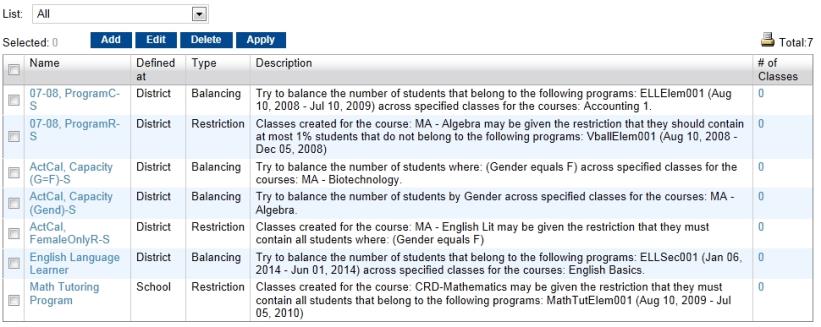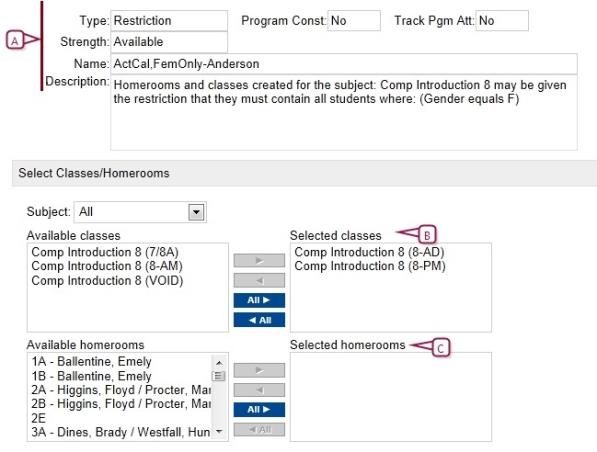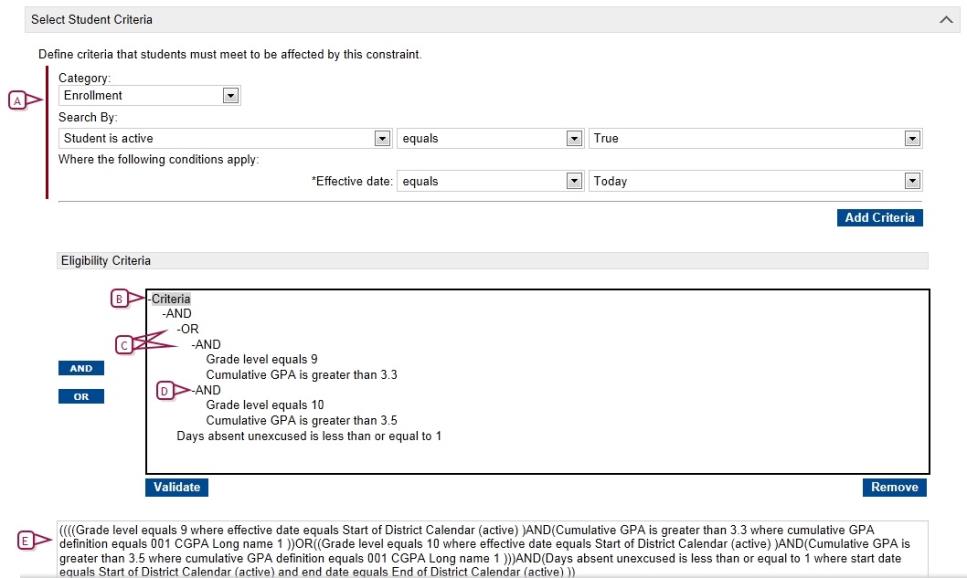Open topic with navigation
| Scheduling > Common scheduling tasks > Set constraints
Set constraints
[Applies to elementary [>>] and secondary school scheduling.]
Constraints enable you to control the PowerSchool SMS automatic scheduler's distribution of students in classes (and, in an elementary school, homerooms) by setting eligibility criteria. For example, using constraints you can limit the class size of a science lab, set up an all-girl physical education class, or ensure a homeroom has only one student for whom English is a second language.
You can apply two types of constraints:
|
=
|
Restriction: Controls the distribution of students in classes according to specific criteria. For example, you can ensure that at least 10 percent of the students in a class are girls or restrict a class to students for whom English is their second language. |
|
=
|
Capacity Balance: Ensures that the automatic scheduler distributes students evenly among available classes based on certain criteria. For example, you can specify that students whose ethnicity is "African American" be distributed evenly among all available classes. Characteristics you can balance across classes include: |
Age (current)
Federal ethnicity category
Gender
Geocode (active)
Geocode (planning)
Grade level (current)
Note: This type of constraint applies only where automatic scheduling is employed; it does not apply when you assign students one by one to a class.
Note: When creating student schedules, the Student Loader only considers constraints if the Use Capacity Balancing Constraints or Use Restriction Constraints option is selected on the Student Loader Options page [see Set student loader options >>].
A District or School Administrator can define a constraint [>>]. As a School Administrator, you apply a constraint to a specific class or homeroom [>>]. Where a homeroom or class has constraints applied, PowerSchool SMS evaluates each student against the constraints' eligibility criteria at the time you assign a student to that class or homeroom. If the student does not meet the eligibility criteria, PowerSchool SMS displays an error message.
Note: A District Administrator can define a constraint for a custom field [>>]. For this constraint to apply, the setting for the Override Constraints permission must be No [>>].
Caution: To ensure accurate results when PowerSchool SMS calculates student eligibility, make sure student information is complete. When PowerSchool SMS processes an eligibility criterion that references a field that is empty, the student meets the criterion only if that criterion employs the "is empty" operator (that is, with any other operator PowerSchool SMS considers the return on that field as false). For example, if a student's Date of Birth field is empty, PowerSchool SMS would evaluate the following criterion as true: "age is empty". However, PowerSchool SMS would evaluate the following criterion as false: "age does not equal 12".
Applying a constraint
Once it is defined [>>], you can apply a constraint to a specific class or homeroom in one of several ways
|
=
|
To all classes created for a course [secondary] or subject and/or to all homerooms [elementary]
In this case, you can set the constraint(s) strength to be default, optional, or mandatory for the specified subjects or homerooms [see also Defining a constraint >>]. |
|
=
|
To a specific homeroom [elementary only] |
Note: While defining a constraint, you can also apply it to courses [>>].
|
1
|
In the Admin menu, click Scheduling. The Scheduling page appears. |
|
2
|
Under Step 3, click Constraints. The Constraints page appears [Figure 390]. |
|
3
|
In the # of Classes column, click the number. The Apply Constraint page appears. |
|
4
|
Under Select Classes [secondary] or Select Classes/Homerooms [elementary] : |
|
=
|
To view classes for all courses/subjects, select All for Course/Subject. |
|
=
|
Or, to view classes for a specific course/ subject, select the course/subject. |
|
=
|
To apply the constraint to a class, move the class to the Selected classes column. |
|
=
|
[elementary only] To apply the constraint to a homeroom, move the homeroom to the Selected homerooms column |
Figure 390: Constraints page

Figure 391: Apply Constraint page

|
A
|
Constraint description: An example of Type is "Restriction". Strength can be "Available", "Default", or "Mandatory". |
|
B
|
Selected classes: This option is available if the constraint is available to subjects or a default [>>]. This option is not available if the constraint is mandatory for the subject. |
|
C
|
Selected homerooms: This option is available only if the constraint is available to homerooms [>>]. This option is not available if the constraint is mandatory for homerooms. |
|
1
|
In the Admin menu, click Scheduling. The Scheduling page appears. |
|
2
|
Click Master Schedule [secondary] or Class Setup [elementary]. The Class Setup page appears. |
|
3
|
Find and view classes by searching by subject, teacher, or room. The Master Schedule/Class Setup page appears. |
|
=
|
Click Display All Records to view all classes available. |
|
4
|
Under Course/Subject Search Results, select one or more classes. A Class Constraints panel appears. |
|
5
|
Under Class Constraints, move selected Available constraints to Selected constraints. |
Defining a constraint
A District Administrator defines a constraint, which is then available to all schools in the district. A School Administrator can modify a district-level constraint for use at a school; PowerSchool SMS creates a school-level definition of the constraint (without modifying the district-level version).
|
1
|
In the Admin menu, click Scheduling or, if you are a District Administrator, click District Setup. The Scheduling page appears or, if you are a District Administrator, the District Setup page appears. |
|
2
|
Click Course Catalog, and then click Constraints or, if you are a District Administrator, click Constraints (Elementary) or Constraints (Secondary). The Constraints page appears [Figure 390]. |
|
=
|
To adjust an existing constraint, in the Name column click its name, or select the constraint and click Edit. Note: When a School Administrator edits a district-defined constraint, PowerSchool SMS creates a school-level copy of that constraint; the district-level constraint stays untouched and is available at the district and school levels. |
|
=
|
To delete a constraint, select the constraint and click Delete. Note: A School Administrator cannot delete a district-defined constraint. |
|
3
|
Click Add. The Add Constraint page appears. |
|
4
|
The Add/Edit Constraint page has the following options: |
|
=
|
Name: The constraint's name must be unique among those available to a school. |
|
=
|
Defined At [school only]: Indicates the level at which the constraint was created: School or District. |
|
=
|
Program Constraint: Indicates that the constraint applies to the specialized activities or courses outside of regular academic studies, that is, through Program Management [>>]. When selected, Program category and Program appear under Select Student Criteria. To use a constraint for a program: |
|
=
|
Select the program category and program. The program sessions display under Available sessions. |
|
=
|
Double-click the program session. The program session appears under Selected sessions. |
|
=
|
Track Program Attendance for Classes with this Constraint: Ensures that PowerSchool SMS includes these classes in instructional minute calculations. |
|
=
|
Constraint type: Restriction or Capacity Balancing [>>]. |
|
5
|
Under Complete the following phrase to define the constraint, construct the constraint statement: |
|
=
|
Select the constraint strength: |
|
=
|
Select "Must contain" to have PowerSchool SMS automatically not schedule a student who does not satisfy the criteria. |
|
=
|
Select "Should contain" to have PowerSchool SMS automatically attempt schedule a student who satisfies the criteria. However, if another class or homeroom is not available, PowerSchool SMS schedules any student who does not satisfy the criteria. |
|
=
|
Set the constraint range and value: |
|
=
|
"At most": The maximum number of students that can have the specified criteria. |
|
=
|
"All": All students must satisfy the criteria for PowerSchool SMS to schedule them. This option is equivalent to "must contain 100%". |
|
=
|
"No": No students need satisfy the criteria for PowerSchool SMS to schedule them. This option is equivalent to "must contain 0%". |
|
=
|
Set the matching criteria to "Matching" or "Not matching". |
|
6
|
Under Select Student Criteria, set the criteria that a student must satisfy to be eligible to be scheduled into the class or homeroom. Add one or more criteria to Eligibility Criteria as follows [Figure 392]: |
|
a
|
For Category, select the type of data to be added; for example, Attendance, Demographics, Enrollment, Grading, Health. |
|
b
|
For Search By, select a field or function [Figure 393]. Selections available depend on the Category selected. |
|
c
|
Select an appropriate operator, for example, equals, is greater than, is less than. |
|
d
|
Set appropriate values (text is case sensitive). |
|
e
|
Click Add Criteria. PowerSchool SMS adds the criterion to the bottom of the list of criteria, below any selected criterion. |
|
7
|
Work with the Eligibility Criteria until the set is valid and useful: |
|
a
|
To delete a criterion, select it and click Remove. |
|
b
|
To add a logical operator to define the relationships between criteria, select "Criteria" or an operator and click AND or OR. |
|
c
|
To move a criterion, click and drag it. |
|
d
|
To validate the Eligibility Criteria, click Validate. |
|
e
|
If, under Define Constraint, Program Constraint is selected, specify the programs in which a student must be enrolled by selecting a Program Category, selecting a Program and moving selected Available sessions to the Selected sessions list. |
|
8
|
[Optional] If the Constraint type is Capacity Balancing, under Select Student Criteria, for Balance By select the characteristic you want to balance across classes. |
|
9
|
Assign the constraint to one or more courses: |
|
a
|
Search for particular courses or click Display All Records. |
|
b
|
Move the course(s) to the Selected Courses list. |
|
c
|
For Constraint Is, select an option: Available: The constraint is available to classes for this course. It is not automatically assigned to classes. This is the default choice. Default: The constraint is applied by default to newly created classes for this course, but the administrator can remove it for specific classes. Mandatory: The constraint is required for all classes for this course and cannot be turned off for any class. Note: You can also assign a constraint to a class using the Master Schedule page [>>]. |
Figure 392: Constraint Eligibility Criteria building example

|
A
|
Criterion builder: Click Add Criteria to add the criterion to the Eligibility Criteria. |
|
B
|
Eligibility Criteria tree presentation: Multiple criteria must conform to the "Rule of Two", that is, each operator must have a pair of items nested underneath. Item pairs can be either two criteria or one criteria and an operator (AND/OR). |
|
C
|
Logical operator: Operators are necessary where there is more than one criterion. For example, if a student must meet all the criteria, the first node under Criteria must be AND; if a student must only meet one of the criteria, the first node should be OR. |
|
D
|
Node: You can re-arrange nodes by clicking a node and dragging it to another location in the statement. |
|
E
|
Eligibility criteria statement: A plain-language version of the saved/validated criteria. |
Figure 393: Criterion function example

|
A
|
Search By: When a function is selected, you can specify conditions under Where the following conditions apply. Select an operator and a value to complete the criterion. |
|
B
|
Function: A predefined tool used to construct statements about complex data that require you to specify limiting or "where" clauses. For example, if you specify that a student must have a cumulative GPA of 3.5, PowerSchool SMS will look at all cumulative GPA definitions. However, if you use a cumulative GPA function, PowerSchool SMS generates additional Search By sets to enable you to select a specific GPA definition. |
|
C
|
Where the following conditions apply: Appears when a function is selected. Any limiting terms necessary to extract the appropriate data are preset. |
|
D
|
Function parameter: The options available for some parameters depend on the level: district or school.At the district level, you can select from a list of values from any school in the district; at the school level, the selection is limited to that of the school.A criterion created at the district using a value that is defined at all schools but one, will exclude any students from that one school. |

www.powerschool.com
Tel: 866-434-6276
Email: smssupport@powerschool.com
Copyright 2015-2016 PowerSchool Group LLC and/or its affiliate(s). All rights reserved. All trademarks are either owned or licensed by PowerSchool Group LLC and/or its affiliates.
 You can do this if your role is School Administrator.[SA]
You can do this if your role is School Administrator.[SA]
 You can do this if your role is School Administrator.[SA]
You can do this if your role is School Administrator.[SA]




